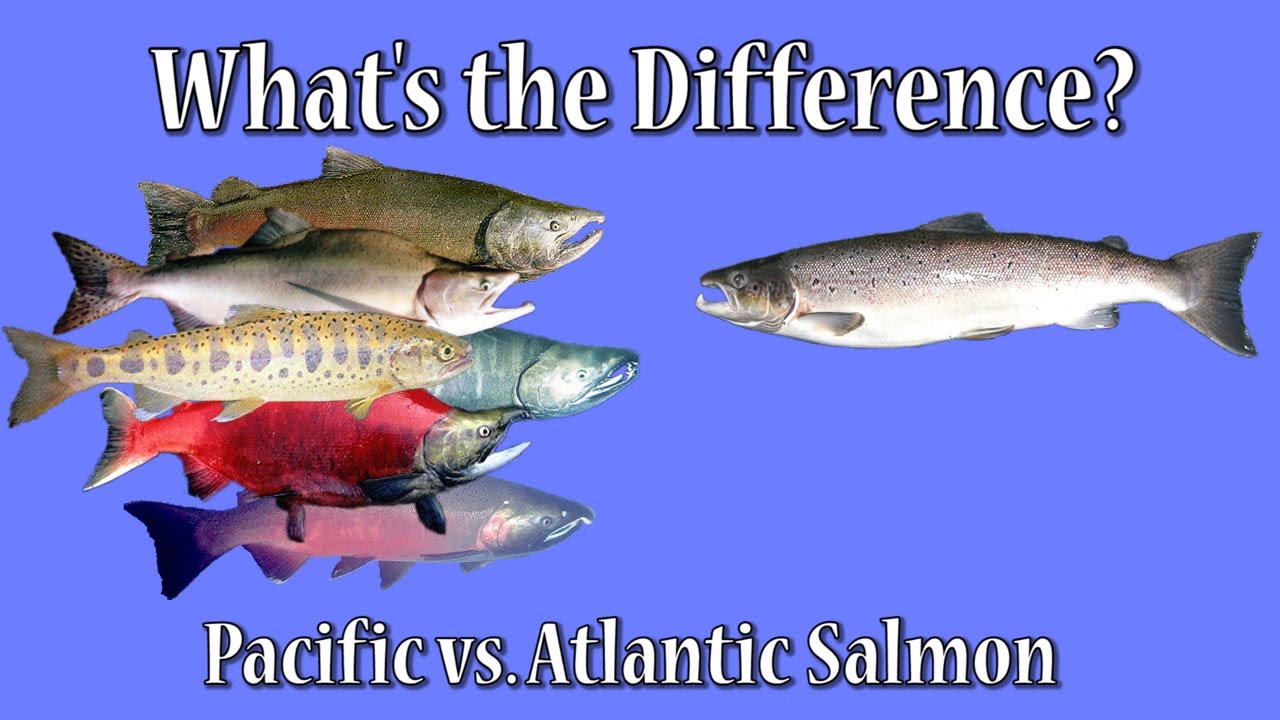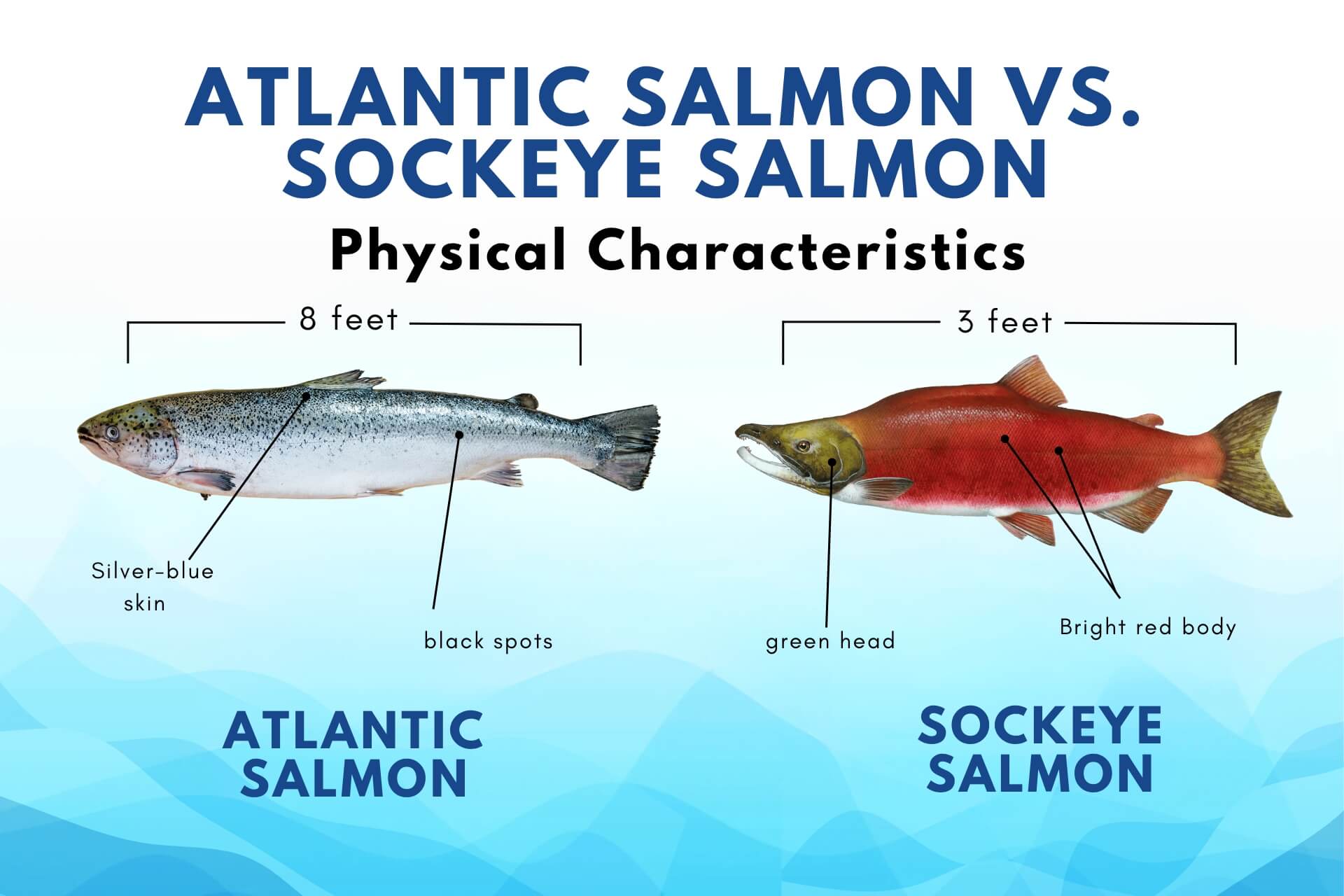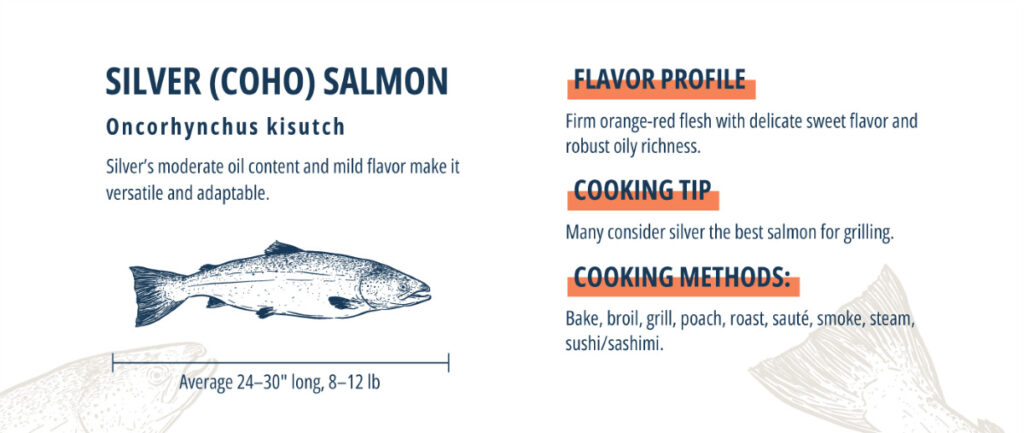Introduction

Salmon is a popular and highly prized fish that comes in different varieties. Among the most well-known are Atlantic salmon and Pacific salmon. These two species have their own unique characteristics, flavors, and habitats. Understanding the differences between Atlantic and Pacific salmon is important for both culinary and environmental reasons. In this article, we will explore the distinct features, nutritional values, and culinary uses of both Atlantic and Pacific salmon. We will also discuss the environmental impacts and sustainability considerations associated with these fish. Whether you are a seafood enthusiast or simply curious about these fascinating creatures, this article is for you.
Overview Of Atlantic Salmon
Atlantic salmon, scientifically known as Salmo salar, is a migratory fish species native to the North Atlantic Ocean. These remarkable fish have a life cycle that takes them from freshwater rivers and streams to the vast depths of the ocean and back again. Atlantic salmon are known for their silver coloration and streamlined bodies, which allow them to navigate swiftly through water. They are a prized catch for anglers and are highly valued for their rich flavor and tender flesh. In recent years, commercial aquaculture has played a significant role in meeting the demand for Atlantic salmon.
Overview Of Pacific Salmon
Pacific salmon, also known as Oncorhynchus species, encompass a group of fish that are native to the Pacific Ocean and its surrounding rivers and streams. These salmon species include Chinook, Coho, Sockeye, Pink, and Chum salmon. Pacific salmon are known for their distinct flavors and vibrant colors, ranging from deep red to pale pink. They have a similar life cycle to Atlantic salmon, migrating from freshwater rivers to the ocean and back to spawn. Pacific salmon are highly valued for their nutritional benefits, as they are rich in omega-3 fatty acids and protein. Commercial fishing and sustainable harvesting practices have been implemented to support the conservation of Pacific salmon populations.
Atlantic Salmon

Atlantic salmon, also known as Salmo salar, are a species of fish that inhabit the Atlantic Ocean. They are slightly smaller and thinner compared to their Pacific counterparts. Atlantic salmon have a distinct life cycle that includes migrating from freshwater rivers to the ocean and back to spawn. They are known for their silver scales and a mix of blue and green hues. Atlantic salmon have a mild and delicate flavor, making them a popular choice in culinary dishes. They are also rich in omega-3 fatty acids and protein, providing numerous health benefits. [5]
Characteristics And Habitat Of Atlantic Salmon
Atlantic salmon, also known as Salmo salar, have several distinct characteristics and a unique habitat. They have a sleek, silver-colored body with a mix of blue and green hues. Atlantic salmon are slightly smaller and thinner compared to their Pacific counterparts. They have sharp teeth and a strong jaw structure, which helps them catch prey.
These salmon species are anadromous, meaning they migrate from freshwater rivers to the ocean and back to spawn. They require clean and well-oxygenated water for breeding. Atlantic salmon are found in the Atlantic Ocean, specifically in regions such as the North Atlantic and the Baltic Sea.
In freshwater, Atlantic salmon prefer clear and cold rivers with gravel or pebble substrates. They spawn in upstream areas with suitable spawning grounds. After hatching, juvenile salmon spend a few years in freshwater before migrating to the ocean, where they mature and grow.
Overall, Atlantic salmon have unique characteristics and a specific habitat that contribute to their distinct behavior and life cycle.
Nutritional Value And Culinary Uses Of Atlantic Salmon
Atlantic salmon is not only delicious but also packed with essential nutrients. It is a great source of protein, omega-3 fatty acids, vitamin D, vitamin B12, and selenium. These nutrients provide numerous health benefits, including improving heart health, brain function, and reducing inflammation.
In terms of culinary uses, Atlantic salmon is incredibly versatile. It can be prepared in various ways such as grilling, baking, broiling, or poaching. It pairs well with a variety of flavors and ingredients, making it a popular choice for dishes like salmon fillets, sushi, smoked salmon, or salmon salads. Its mild, delicate flavor makes it a favorite among seafood lovers.
Pacific Salmon

Pacific Salmon, also known as wild salmon, are a group of salmon species primarily found in the Pacific Ocean. This includes species such as Chinook, Sockeye, Coho, Pink, and Chum salmon. Pacific salmon are known for their vibrant colors, ranging from bright red to silver. They have a rich and robust flavor, with a firm texture that holds up well to cooking methods like grilling and smoking. Pacific salmon are highly valued for their high omega-3 fatty acid content, making them a nutritious choice for a balanced diet. They are popular in dishes like sushi, sashimi, and salmon steaks.
Characteristics And Habitat Of Pacific Salmon
Pacific salmon, including species such as Chinook, Sockeye, Coho, Pink, and Chum salmon, have distinct characteristics and inhabit various regions in the Pacific Ocean. They are known for their vibrant colors, ranging from bright red to silver. Pacific salmon have a streamlined body shape with a single dorsal fin, and they can grow to different sizes depending on the species. They are anadromous, meaning they are born in freshwater rivers and streams, migrate to the ocean to mature, and then return to their natal rivers to spawn. Different species of Pacific salmon have specific habitat preferences, such as spawning in different types of rivers and requiring specific water temperature conditions. They play a crucial ecological role in the Pacific ecosystem, delivering nutrients from the ocean to freshwater systems during their annual migrations.
Nutitional Value And Culinary Uses Of Pacific Salmon
Pacific salmon is not only delicious but also highly nutritious. It is rich in omega-3 fatty acids, which are essential for heart health and brain function. Pacific salmon is a great source of high-quality protein, vitamins (such as B vitamins and vitamin D), and minerals (including potassium and selenium).
In terms of culinary uses, Pacific salmon is incredibly versatile. It can be grilled, baked, broiled, or even eaten raw as sushi or sashimi. Its rich and buttery flavor pairs well with a variety of seasonings and sauces, making it a favorite choice for many recipes. From salmon steaks and fillets to salads, soups, and pasta dishes, Pacific salmon adds a delicious and nutritious element to any meal.
Differences Between Atlantic Salmon And Pacific Salmon

Atlantic salmon and Pacific salmon differ in several ways, including their physical characteristics, flavor, and texture. Atlantic salmon typically have a lighter flesh color and milder flavor compared to Pacific salmon, which is known for its rich, flavorful taste. Pacific salmon also tends to have a firmer texture, making it ideal for grilling and broiling. Another key difference is their habitat, as Atlantic salmon are primarily found in the North Atlantic, while Pacific salmon is native to the Pacific Ocean and its surrounding rivers. Overall, these variations make each type of salmon unique and sought after by seafood lovers.
Physical Differences
Physical differences between Atlantic salmon and Pacific salmon are apparent when comparing their appearance and body characteristics. Atlantic salmon typically have a lighter pink flesh color, while Pacific salmon exhibits a richer and deeper pink hue. In terms of texture, Atlantic salmon has a softer and more delicate consistency, whereas Pacific salmon has a firmer flesh. Additionally, Atlantic salmon tend to be smaller in size compared to the larger Pacific salmon species. These physical distinctions contribute to the unique qualities and culinary uses of each type of salmon.
Flavor And Texture Variations
Flavor and texture variations are notable differences between Atlantic salmon and Pacific salmon. Atlantic salmon tends to have a milder taste with a delicate flavor profile. Its flesh is softer and has larger flakes. On the other hand, Pacific salmon offers a richer and more pronounced flavor, with a firmer texture. The flesh of Pacific salmon is known for its deep pink hue and a meatier consistency. These variations in flavor and texture contribute to different culinary uses and preferences, allowing individuals to choose based on their personal taste preferences.
Environmental Impact And Sustainability

The intensive farming practices associated with Atlantic salmon production have raised concerns about their environmental impact. These practices can lead to issues such as water pollution, disease outbreaks, and the use of antibiotics and pesticides. Additionally, escaped farm-raised salmon can compete with and interbreed with wild salmon, affecting their genetic diversity. On the other hand, Pacific salmon is often caught through sustainable fishing practices, which prioritize the long-term health of fish populations and the marine ecosystem. These practices include regulated fishing seasons, catch limits, and the use of selective fishing gear to reduce bycatch.
Environmental Concerns Related To Atlantic Salmon Farming
The intensive farming practices associated with Atlantic salmon production have raised concerns about their environmental impact. These practices can lead to issues such as water pollution, disease outbreaks, and the use of antibiotics and pesticides. Additionally, escaped farm-raised salmon can compete with and interbreed with wild salmon, affecting their genetic diversity. These environmental concerns highlight the need for more sustainable and responsible farming practices in order to minimize the negative impact on ecosystems and protect wild salmon populations. [25]
Sustainable Fishing Practices For Pacific Salmon
Sustainable fishing practices for Pacific Salmon involve implementing measures that prioritize the long-term health and conservation of the species and their ecosystems. These practices include:
- Regulated fishing seasons: Fisheries management agencies establish specific seasons and limits to ensure that salmon populations are not overexploited during their spawning and migration periods.
- Size and species restrictions: Regulations are in place to protect smaller salmon and specific species to allow them to reach their spawning grounds and maintain genetic diversity.
- Fishing gear modifications: Using selective fishing gear, such as drift nets and fish wheels, helps reduce bycatch of non-target species and protects the overall ecosystem.
- Monitoring and research: Regular monitoring of salmon populations, habitat conditions, and fishing practices allows for adaptive management and informed decision-making for sustainable fishing practices.
- Habitat conservation: Protecting and restoring salmon habitats, such as rivers and streams, is crucial for their survival and successful reproduction.
By implementing these sustainable fishing practices, we can ensure the long-term viability and conservation of Pacific Salmon populations while still providing a sustainable source of this valuable seafood. [28]
Conclusion

In conclusion, Atlantic Salmon and Pacific Salmon are both highly nutritious and delicious seafood options. While they have some minor physical and flavor differences, these variations do not significantly affect their overall culinary value. Whether you choose Atlantic Salmon or Pacific Salmon, you can enjoy the unique flavors and textures they offer. However, it is important to consider the environmental impact and sustainability practices associated with Atlantic Salmon farming. By opting for Pacific Salmon and supporting sustainable fishing practices, we can ensure the long-term conservation of salmon populations and their ecosystems, while still indulging in their delectable taste.
Key Takeaways And Considerations
When it comes to choosing between Atlantic Salmon and Pacific Salmon, there are a few key takeaways and considerations to keep in mind. Here are some important points to remember:
- Availability: Atlantic Salmon is typically available year-round, while Pacific Salmon is more seasonal.
- Flavor and Texture: Atlantic Salmon tends to have a milder flavor and a softer texture, while Pacific Salmon has a richer and more intense flavor.
- Environmental Impact: It is important to consider the environmental impact of Atlantic Salmon farming, as it can have negative effects on the ecosystem. Opting for sustainable fishing practices for Pacific Salmon supports long-term conservation efforts.
- Nutritional Value: Both Atlantic Salmon and Pacific Salmon are rich in omega-3 fatty acids and offer excellent nutritional benefits.
- Personal Preference: Ultimately, the choice between Atlantic Salmon and Pacific Salmon depends on personal taste preferences and the availability of each variety.
By considering these factors, you can make an informed decision and enjoy the delicious and nutritious benefits of either Atlantic or Pacific Salmon.
Delicious Recipes Featuring Atlantic And Pacific Salmon
Looking to cook up some delicious dishes using Atlantic and Pacific Salmon? Try these mouthwatering recipes that showcase the unique flavors of each variety:
- Grilled Atlantic Salmon with Lemon Herb Butter: A simple yet flavorful recipe, this grilled Atlantic Salmon is topped with a tangy lemon herb butter that enhances its delicate taste.
- Pan-Seared Pacific Salmon with Teriyaki Glaze: This recipe features pan-seared Pacific Salmon glazed with a sweet and savory teriyaki sauce, creating a succulent and satisfying meal.
- Baked Atlantic Salmon with Dijon Mustard Crust: Tender Atlantic Salmon is coated with a crispy Dijon mustard crust and baked to perfection, resulting in a delightful combination of textures and flavors.
- Miso Glazed Pacific Salmon: A popular Japanese-inspired dish, this recipe involves marinating Pacific Salmon in a savory miso glaze, which adds depth and complexity to its rich flavor.
These recipes will allow you to savor the unique taste and texture of both Atlantic and Pacific Salmon varieties, making for a truly satisfying dining experience. Happy cooking! [34]
Frequently Asked Questions – Atlantic Salmon vs Pacific Salmon
Q: What is the main difference between Atlantic Salmon and Pacific Salmon?
A: The main difference lies in the species of salmon and the oceanic regions they inhabit. Atlantic salmon (Salmo salar) is native to the North Atlantic Ocean, while Pacific salmon refers to multiple species found in the North Pacific Ocean.
Q: Do the two types of salmon taste different?
A: Yes, there is a slight difference in taste, primarily due to differences in diet and living conditions. Atlantic salmon has a milder and less fishy flavor, while Pacific salmon tends to have a richer and oilier taste.
Q: Can you tell me about the physical appearance of these salmon varieties?
A: Certainly! Atlantic salmon typically have a silver to blue-green color, and their body is spotted with black and dark blue. On the other hand, Pacific salmon species, such as Chinook (King), Sockeye, Coho, and Pink salmon, exhibit distinct variations in color, ranging from red to pale silver, with unique markings and hues.
Q: Are there differences in the nutritional value of Atlantic and Pacific salmon?
A: In terms of nutritional value, both types of salmon offer a rich source of omega-3 fatty acids, high-quality protein, and essential vitamins and minerals. However, the specific nutrient content may vary slightly between species and individual fish due to factors such as diet and habitat.
Q: Which salmon is more readily available in grocery stores?
A: Typically, Pacific salmon varieties are more widely available in North American grocery stores due to their abundance and commercial fishing practices. Atlantic salmon is often farmed, making it more accessible year-round.
Q: Are there any sustainability differences between Atlantic and Pacific salmon?
A: Sustainability can vary between species and fishing practices. Wild Pacific salmon populations are managed more rigorously, with established regulations and quotas to maintain sustainable fishing. Atlantic salmon, on the other hand, has some wild populations but is predominantly farmed, requiring careful monitoring to minimize environmental impacts.
Q: Are there any cultural or regional preferences for either type of salmon?
A: Yes, there are cultural and regional preferences depending on the geographic area. For example, Pacific salmon is highly valued in North America and is a staple in Indigenous cultures, while Atlantic salmon is popular in European cuisine, particularly in Scandinavia and Scotland.
Q: Can I use Atlantic and Pacific salmon interchangeably in recipes?
A: Yes, you can substitute one variety for the other in many recipes, considering the flavor and texture differences. However, it is important to note that cooking times and techniques may need slight adjustments for optimal results.
Q: Which type of salmon is typically more expensive?
A: Prices can vary depending on factors such as sourcing, availability, and market demand. Generally, wild-caught Pacific salmon, particularly species like Sockeye and Chinook, tends to be more expensive due to its limited supply and higher demand. Farmed Atlantic salmon is often more affordable.
Q: Which type of salmon is healthier for consumption?
A: Both types of salmon provide numerous health benefits due to their omega-3 fatty acid content. However, wild Pacific salmon is considered to have a slight advantage in terms of nutritional value and potential lower levels of contaminants.
Please note that this FAQ provides a general overview, and individual variations may exist within each species of salmon. It is always best to refer to specific nutritional information, product origins, and sustainable sourcing practices when making purchasing decisions.

A small, independently run fish and chip shop using quality ingredients cooked freshly in our kitchen to ensure great tasting food. All of our drinks are in glass bottles, and all of our takeaway packaging is recyclable or compostable to help reduce our impact on the environment.